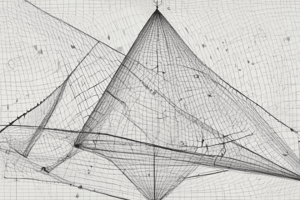Podcast
Questions and Answers
What mathematical construct features perpendicular x and y-axes?
What mathematical construct features perpendicular x and y-axes?
- Spherical coordinates
- Cartesian plane (correct)
- Polar plane
- Polar coordinates
Which axis on the Cartesian plane typically represents the vertical component of a vector?
Which axis on the Cartesian plane typically represents the vertical component of a vector?
- w-axis
- y-axis (correct)
- z-axis
- x-axis
What method simplifies calculations involving vectors not aligned with the principal axes?
What method simplifies calculations involving vectors not aligned with the principal axes?
- Vector addition method
- Scalar multiplication method
- Component decomposition method (correct)
- Graphical method
What is crucial in understanding how multiple vectors combine to produce a single vector?
What is crucial in understanding how multiple vectors combine to produce a single vector?
How can the resultant of perpendicular vectors be determined?
How can the resultant of perpendicular vectors be determined?
In a two-dimensional space, what does the x-axis typically represent for a vector?
In a two-dimensional space, what does the x-axis typically represent for a vector?
What is fundamental in describing physical quantities such as force, velocity, and displacement?
What is fundamental in describing physical quantities such as force, velocity, and displacement?
What method can be used to simplify calculations involving vectors not aligned with the principal axes?
What method can be used to simplify calculations involving vectors not aligned with the principal axes?
How do perpendicular vectors combine to produce a resultant vector?
How do perpendicular vectors combine to produce a resultant vector?
What is most useful in representing vectors in a two-dimensional space?
What is most useful in representing vectors in a two-dimensional space?
How does resolving a vector into horizontal and vertical components simplify problem-solving?
How does resolving a vector into horizontal and vertical components simplify problem-solving?
What trigonometric ratios are used to determine the horizontal and vertical components of a vector?
What trigonometric ratios are used to determine the horizontal and vertical components of a vector?
In which scenario should vectors be resolved into components parallel to the x- and y-axes?
In which scenario should vectors be resolved into components parallel to the x- and y-axes?
How can the magnitude of the horizontal component of a vector be calculated?
How can the magnitude of the horizontal component of a vector be calculated?
Why is it beneficial to sketch vectors and their components when adding vectors using components?
Why is it beneficial to sketch vectors and their components when adding vectors using components?
What is the essential step in determining the resultant vector when adding vectors using components?
What is the essential step in determining the resultant vector when adding vectors using components?
How does resolving vectors into components aid in vector analysis?
How does resolving vectors into components aid in vector analysis?
What is the primary advantage of resolving vectors into horizontal and vertical components?
What is the primary advantage of resolving vectors into horizontal and vertical components?
What trigonometric identity is used to find the horizontal component of a vector?
What trigonometric identity is used to find the horizontal component of a vector?
If a vector has a magnitude of 18 units, what is the horizontal component when its angle with the x-axis is 45 degrees?
If a vector has a magnitude of 18 units, what is the horizontal component when its angle with the x-axis is 45 degrees?
How can the magnitude of the resultant vector of two perpendicular vectors be calculated?
How can the magnitude of the resultant vector of two perpendicular vectors be calculated?
What principle underpins the concept of vector equality?
What principle underpins the concept of vector equality?
What method is used to graphically add vectors to determine the resultant vector?
What method is used to graphically add vectors to determine the resultant vector?
What mathematical tool is used to determine the angle of the resultant vector relative to the x-axis?
What mathematical tool is used to determine the angle of the resultant vector relative to the x-axis?
What is the purpose of decomposing a vector into components?
What is the purpose of decomposing a vector into components?
Which calculation method is used to determine the magnitude of the resultant vector when vectors are perpendicular?
Which calculation method is used to determine the magnitude of the resultant vector when vectors are perpendicular?
How does graphical addition represent individual vectors?
How does graphical addition represent individual vectors?
What concept does vector equality emphasize?
What concept does vector equality emphasize?
What mathematical tool can be used to calculate angles in vector components?
What mathematical tool can be used to calculate angles in vector components?
What does resolving a vector into components refer to?
What does resolving a vector into components refer to?
What method is used to simplify the analysis and solution of vector-related problems?
What method is used to simplify the analysis and solution of vector-related problems?
How can a vector in a two-dimensional space be broken down for analysis?
How can a vector in a two-dimensional space be broken down for analysis?
What trigonometric identity is used to determine the horizontal component of a vector?
What trigonometric identity is used to determine the horizontal component of a vector?
How are the x- and y-components of vectors combined to find the resultant vector?
How are the x- and y-components of vectors combined to find the resultant vector?
What is the primary advantage of resolving vectors into their orthogonal components?
What is the primary advantage of resolving vectors into their orthogonal components?
What is the purpose of utilizing trigonometric ratios when resolving vectors into components?
What is the purpose of utilizing trigonometric ratios when resolving vectors into components?
How do perpendicular vectors combine to produce a resultant vector?
How do perpendicular vectors combine to produce a resultant vector?
What is the primary advantage of using the Cartesian plane in analyzing vectors?
What is the primary advantage of using the Cartesian plane in analyzing vectors?
When vectors are not aligned with the principal axes, what method can be used to simplify calculations?
When vectors are not aligned with the principal axes, what method can be used to simplify calculations?
How are multiple vectors combined to produce a single vector in vector analysis?
How are multiple vectors combined to produce a single vector in vector analysis?
In the Cartesian plane, what does the y-axis typically represent for a vector?
In the Cartesian plane, what does the y-axis typically represent for a vector?
What mathematical concept is crucial when adding perpendicular vectors graphically?
What mathematical concept is crucial when adding perpendicular vectors graphically?
What approach can be used to find the direction of the resultant vector when adding perpendicular vectors?
What approach can be used to find the direction of the resultant vector when adding perpendicular vectors?
When vectors are perpendicular, what type of calculations can be utilized to determine their resultant?
When vectors are perpendicular, what type of calculations can be utilized to determine their resultant?
What is the most effective method to determine the magnitude of the resultant vector when vectors are perpendicular?
What is the most effective method to determine the magnitude of the resultant vector when vectors are perpendicular?
How does resolving vectors into components simplify calculations involving non-aligned vectors?
How does resolving vectors into components simplify calculations involving non-aligned vectors?
What is a significant application of decomposing vectors into their orthogonal components?
What is a significant application of decomposing vectors into their orthogonal components?
When resolving a vector into components, why are the horizontal and vertical components typically chosen?
When resolving a vector into components, why are the horizontal and vertical components typically chosen?
How can the horizontal component of a vector be calculated using trigonometry?
How can the horizontal component of a vector be calculated using trigonometry?
What is the primary advantage of representing vectors as components aligned with the coordinate axes?
What is the primary advantage of representing vectors as components aligned with the coordinate axes?
In vector addition using components, why is it essential to sum all horizontal (x) components separately?
In vector addition using components, why is it essential to sum all horizontal (x) components separately?
What mathematical construct allows for the application of trigonometric identities in resolving vectors?
What mathematical construct allows for the application of trigonometric identities in resolving vectors?
When adding vectors using components, what method is employed to determine the resultant vector?
When adding vectors using components, what method is employed to determine the resultant vector?
Why are perpendicular vectors resolved into x- and y-components in vector analysis?
Why are perpendicular vectors resolved into x- and y-components in vector analysis?
How does representing vectors as x- and y-components facilitate algebraic vector addition?
How does representing vectors as x- and y-components facilitate algebraic vector addition?
What role do trigonometric identities play in resolving vectors into components?
What role do trigonometric identities play in resolving vectors into components?
Why is it important to sketch vectors and their components when adding vectors using components?
Why is it important to sketch vectors and their components when adding vectors using components?
What mathematical principle can be applied to determine the magnitude of the resultant vector of perpendicular vectors?
What mathematical principle can be applied to determine the magnitude of the resultant vector of perpendicular vectors?
Which trigonometric function is utilized to find the angle of the resultant vector relative to the x-axis?
Which trigonometric function is utilized to find the angle of the resultant vector relative to the x-axis?
What does vector equality emphasize in terms of vector properties?
What does vector equality emphasize in terms of vector properties?
In vector analysis, what is the process of breaking down a single vector into multiple constituent vectors known as?
In vector analysis, what is the process of breaking down a single vector into multiple constituent vectors known as?
Which method visually demonstrates vector addition by aligning vectors' tails with the heads of preceding vectors?
Which method visually demonstrates vector addition by aligning vectors' tails with the heads of preceding vectors?
What important geometric concept allows vectors to be freely translated without altering their characteristics?
What important geometric concept allows vectors to be freely translated without altering their characteristics?
In two-dimensional vector analysis, what method simplifies calculations involving vectors not aligned with the principal axes?
In two-dimensional vector analysis, what method simplifies calculations involving vectors not aligned with the principal axes?
What is the primary purpose of calculating vector components when studying physics?
What is the primary purpose of calculating vector components when studying physics?
Which mathematical tool is utilized to find angles in the two-dimensional analysis of vectors?
Which mathematical tool is utilized to find angles in the two-dimensional analysis of vectors?
What does resolving a vector into components involve in vector analysis?
What does resolving a vector into components involve in vector analysis?
What is the primary function of the Cartesian plane in the analysis of vectors?
What is the primary function of the Cartesian plane in the analysis of vectors?
How does the Cartesian plane contribute to calculating the resultant of perpendicular vectors?
How does the Cartesian plane contribute to calculating the resultant of perpendicular vectors?
When adding perpendicular vectors algebraically, what method can be utilized to determine the magnitude of the resultant vector?
When adding perpendicular vectors algebraically, what method can be utilized to determine the magnitude of the resultant vector?
In two-dimensional vector analysis, what is typically represented by the y-axis in the Cartesian plane?
In two-dimensional vector analysis, what is typically represented by the y-axis in the Cartesian plane?
Why is decomposing vectors into horizontal and vertical components significant in vector analysis?
Why is decomposing vectors into horizontal and vertical components significant in vector analysis?
How can the magnitude of the resultant vector be calculated when dealing with perpendicular vectors?
How can the magnitude of the resultant vector be calculated when dealing with perpendicular vectors?
In vector analysis, what does vector equality emphasize?
In vector analysis, what does vector equality emphasize?
What method visually demonstrates vector addition by aligning vectors' tails with the heads of preceding vectors?
What method visually demonstrates vector addition by aligning vectors' tails with the heads of preceding vectors?
What is the purpose of decomposing a vector into components in vector analysis?
What is the purpose of decomposing a vector into components in vector analysis?
How can the angle of the resultant vector relative to the x-axis be determined when dealing with perpendicular vectors?
How can the angle of the resultant vector relative to the x-axis be determined when dealing with perpendicular vectors?
How can a vector in a two-dimensional space be analytically broken down into components?
How can a vector in a two-dimensional space be analytically broken down into components?
What is the significance of leveraging trigonometric ratios when resolving vectors into components?
What is the significance of leveraging trigonometric ratios when resolving vectors into components?
When resolving vectors into components, what fundamental geometric shape forms the basis for the decomposition?
When resolving vectors into components, what fundamental geometric shape forms the basis for the decomposition?
How does algebraic addition of vector components contribute to finding the resultant vector?
How does algebraic addition of vector components contribute to finding the resultant vector?
In vector addition using components, why is it essential to sum all horizontal (x) components separately?
In vector addition using components, why is it essential to sum all horizontal (x) components separately?
How are vectors typically resolved into components in a two-dimensional space?
How are vectors typically resolved into components in a two-dimensional space?
What trigonometric function is utilized to calculate the horizontal component of a vector?
What trigonometric function is utilized to calculate the horizontal component of a vector?
In two-dimensional vector analysis, what is the purpose of leveraging trigonometric ratios?
In two-dimensional vector analysis, what is the purpose of leveraging trigonometric ratios?
What mathematical tool is essential for determining the vertical component of a vector?
What mathematical tool is essential for determining the vertical component of a vector?
Why is resolving vectors into horizontal and vertical components significant in vector analysis?
Why is resolving vectors into horizontal and vertical components significant in vector analysis?
Which method allows for determining the resultant vector through algebraic addition of x- and y-components?
Which method allows for determining the resultant vector through algebraic addition of x- and y-components?
$\vec{F} = 100$ N is acting at an angle of 45° to the positive x-axis. What would be the vertical component of this force?
$\vec{F} = 100$ N is acting at an angle of 45° to the positive x-axis. What would be the vertical component of this force?
How can the horizontal component of a vector be found using trigonometric identities?
How can the horizontal component of a vector be found using trigonometric identities?
What mathematical concept is crucial in decomposing vectors into their respective components on a Cartesian plane?
What mathematical concept is crucial in decomposing vectors into their respective components on a Cartesian plane?
In the context of vectors, what does the x-axis typically represent on a Cartesian plane?
In the context of vectors, what does the x-axis typically represent on a Cartesian plane?
What is the primary reason for resolving vectors into orthogonal components in problem-solving?
What is the primary reason for resolving vectors into orthogonal components in problem-solving?
When vectors are perpendicular, what method can be used to determine their resultant vector?
When vectors are perpendicular, what method can be used to determine their resultant vector?
When resolving a vector into components, what role do right-angled triangles play?
When resolving a vector into components, what role do right-angled triangles play?
On a Cartesian plane, which mathematical tool is commonly used to find the direction of a vector?
On a Cartesian plane, which mathematical tool is commonly used to find the direction of a vector?
How do trigonometric identities help in determining vector components?
How do trigonometric identities help in determining vector components?
In vector analysis, which geometric entity is used to represent force, velocity, and displacement?
In vector analysis, which geometric entity is used to represent force, velocity, and displacement?
What is a common error students make when calculating vector components using trigonometric ratios?
What is a common error students make when calculating vector components using trigonometric ratios?
Why are vectors resolved into horizontal and vertical components in two-dimensional spaces?
Why are vectors resolved into horizontal and vertical components in two-dimensional spaces?
What mathematical construct features perpendicular x and y-axes for representing vectors on a Cartesian plane?
What mathematical construct features perpendicular x and y-axes for representing vectors on a Cartesian plane?
Why is it significant to decompose vectors into their components before performing calculations?
Why is it significant to decompose vectors into their components before performing calculations?
What does the vertical component of a vector represent in two-dimensional vector analysis?
What does the vertical component of a vector represent in two-dimensional vector analysis?
What plays a crucial role in understanding how multiple vectors combine to produce a single representative vector?
What plays a crucial role in understanding how multiple vectors combine to produce a single representative vector?
Which method can be employed to determine the magnitude of resultant vectors when dealing with perpendicular vectors?
Which method can be employed to determine the magnitude of resultant vectors when dealing with perpendicular vectors?
In vector analysis, what strategy simplifies calculations involving vectors not aligned with the principal axes?
In vector analysis, what strategy simplifies calculations involving vectors not aligned with the principal axes?
What geometric concept allows the vectors to be freely translated across the plane without altering their physical properties?
What geometric concept allows the vectors to be freely translated across the plane without altering their physical properties?
How can the magnitude of a resultant vector be determined when dealing with perpendicular vectors?
How can the magnitude of a resultant vector be determined when dealing with perpendicular vectors?
What is the primary benefit of representing vectors as components aligned with the coordinate axes?
What is the primary benefit of representing vectors as components aligned with the coordinate axes?
How is the direction of the resultant vector calculated when vectors are perpendicular?
How is the direction of the resultant vector calculated when vectors are perpendicular?
Which mathematical principle underpins vector analysis by emphasizing that vectors are equal if they have the same magnitude and direction?
Which mathematical principle underpins vector analysis by emphasizing that vectors are equal if they have the same magnitude and direction?
What method visually demonstrates vector addition by aligning each vector's tail with the head of the preceding vector?
What method visually demonstrates vector addition by aligning each vector's tail with the head of the preceding vector?
In two-dimensional space, what is crucial in breaking down a single vector into multiple vectors that can reconstruct it?
In two-dimensional space, what is crucial in breaking down a single vector into multiple vectors that can reconstruct it?
What tool is utilized to determine angles in two-dimensional vector analysis?
What tool is utilized to determine angles in two-dimensional vector analysis?
What trigonometric function can be used to determine the angle that a resultant vector makes with an axis?
What trigonometric function can be used to determine the angle that a resultant vector makes with an axis?
What mathematical concept is crucial in determining the magnitude of the resultant vector when dealing with perpendicular vectors?
What mathematical concept is crucial in determining the magnitude of the resultant vector when dealing with perpendicular vectors?
In two-dimensional vector analysis, what plays a significant role in simplifying calculations involving vectors not aligned with the principal axes?
In two-dimensional vector analysis, what plays a significant role in simplifying calculations involving vectors not aligned with the principal axes?
Why is decomposing vectors into their respective components considered advantageous in vector analysis?
Why is decomposing vectors into their respective components considered advantageous in vector analysis?
Which trigonometric function is crucial for determining the direction of the resultant vector when adding perpendicular vectors?
Which trigonometric function is crucial for determining the direction of the resultant vector when adding perpendicular vectors?
What is the primary benefit of using graphical methods to determine the resultant of perpendicular vectors?
What is the primary benefit of using graphical methods to determine the resultant of perpendicular vectors?
When resolving vectors into their components, what geometric shape forms the basis for this decomposition method?
When resolving vectors into their components, what geometric shape forms the basis for this decomposition method?
What mathematical method is used to find the magnitude of the resultant vector of two perpendicular vectors?
What mathematical method is used to find the magnitude of the resultant vector of two perpendicular vectors?
When vectors are perpendicular, what does the arctan function help determine?
When vectors are perpendicular, what does the arctan function help determine?
Why is vector equality considered a fundamental concept in vector analysis?
Why is vector equality considered a fundamental concept in vector analysis?
What method visually exemplifies vector addition by connecting the tail of one vector to the head of another?
What method visually exemplifies vector addition by connecting the tail of one vector to the head of another?
In vector analysis, what is the primary advantage of resolving vectors into components?
In vector analysis, what is the primary advantage of resolving vectors into components?
What geometric concept forms the basis for decomposing a vector into its components?
What geometric concept forms the basis for decomposing a vector into its components?
How can a vector in a two-dimensional space be analytically broken down into components?
How can a vector in a two-dimensional space be analytically broken down into components?
What mathematical construct allows for the application of trigonometric identities in resolving vectors?
What mathematical construct allows for the application of trigonometric identities in resolving vectors?
Why is decomposing vectors into horizontal and vertical components significant in vector analysis?
Why is decomposing vectors into horizontal and vertical components significant in vector analysis?
What method is used to determine the magnitude of the resultant vector when vectors are perpendicular?
What method is used to determine the magnitude of the resultant vector when vectors are perpendicular?
What is one purpose of leveraging trigonometric ratios when resolving vectors into components?
What is one purpose of leveraging trigonometric ratios when resolving vectors into components?
How does the Cartesian plane contribute to calculating the resultant of perpendicular vectors?
How does the Cartesian plane contribute to calculating the resultant of perpendicular vectors?
In two-dimensional space, what is crucial in breaking down a single vector into multiple vectors that can reconstruct it?
In two-dimensional space, what is crucial in breaking down a single vector into multiple vectors that can reconstruct it?




